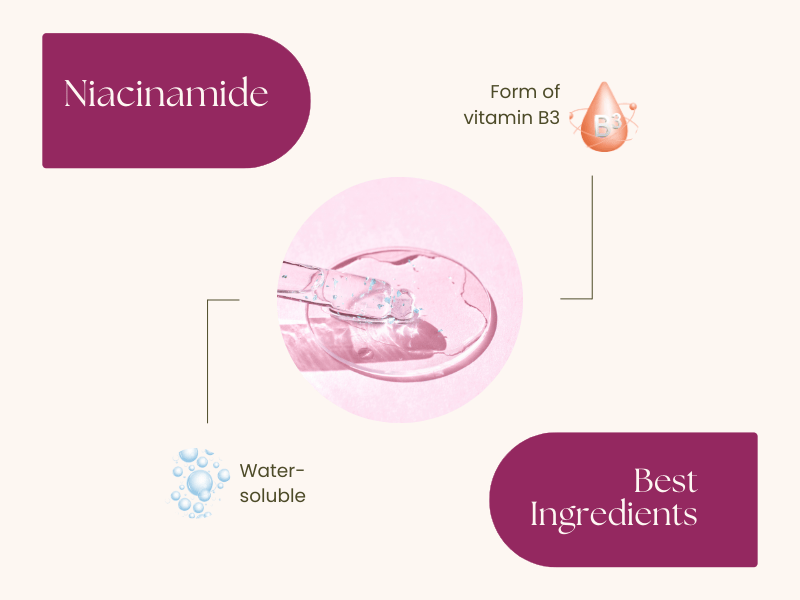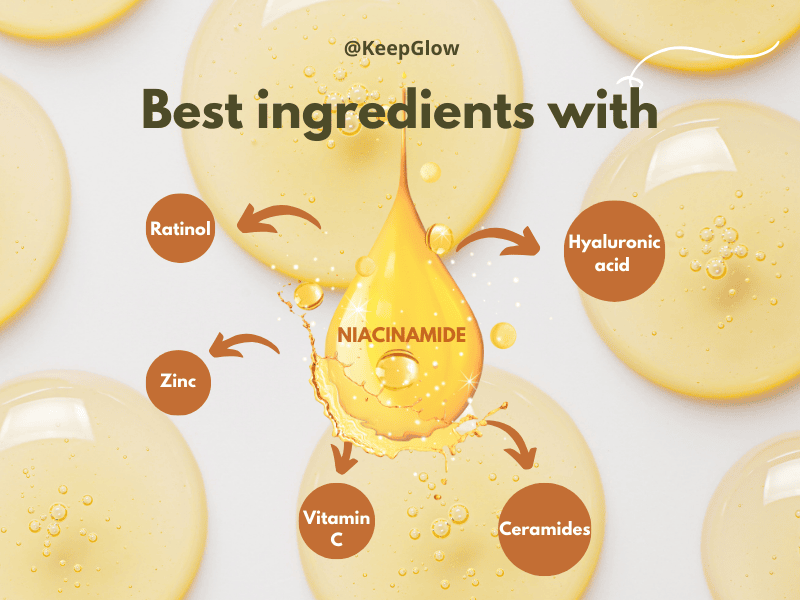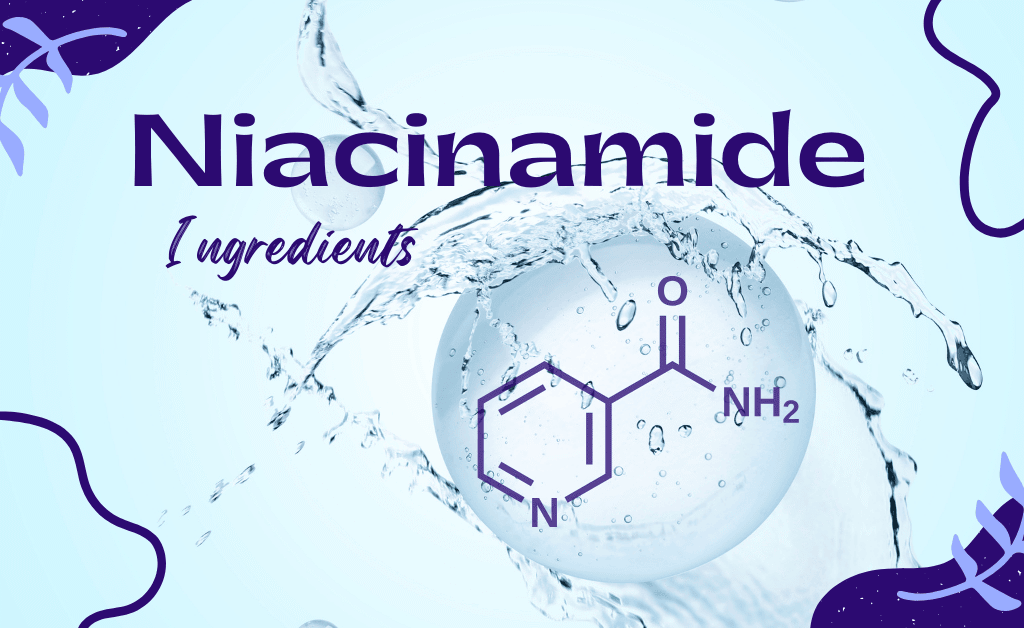Choosing the right product is essential, but it’s equally important to check its ingredients. The ingredients can help you determine which product is practical and valuable for you. To do this, you need to have a basic knowledge of ingredients, including which ones are best suited for your skin and what their effects/side effects will be.
Here, we’ll learn about an ingredient that’s both trending and scientifically proven: Niacinamide and its niacinamide benefits for skin.
In this blog, you’ll learn about each point in detail.
What’s Niacinamide?
Niacinamide (nicotinamide) is a form of vitamin B3 found in skincare products. It is water-soluble, allowing for easy absorption by the skin. It is very effective for the skin. It repairs the skin barrier, brightens the skin, controls oiliness, reduces redness, and even helps signs of premature ageing.

The great thing about this ingredient is that it is a safe and effective option for all skin types, including those with oily, dry, and sensitive skin.
Niacinamide Benefits for Skin
Strengthens the Skin Barrier
This ingredient enhances the skin barrier and supports the production of ceramide proteins. It strengthens the skin barrier, reducing irritation, dryness, and sensitivity.
Hyperpigmentation, Dark Spots, and Even Tone
This ingredient balances the activity of melanocyte cells (which produce melanin), reducing melanin redistribution, thereby minimizing dark spots.
It also fades cane scars, sun spots, pigmentation, suntan, and skin discolouration, resulting in a more even and lighter skin tone regular use will brighten your skin and show visible results.
Anti-inflammatory
If you have skin problems such as acne, irritation, or inflammation, this ingredient is a great option, as it provides a soothing effect.
It reduces inflammation and provides significant relief to your skin.
Collagen and Anti-Ageing Benefits
This ingredient boosts collagen production, reducing the appearance of wrinkles and fine lines. It improves skin elasticity and possesses anti-ageing properties that help slow down the visible signs of ageing.
Oil (Sebum) Control
This ingredient helps control excess oil production, reducing the risk of clogged pores and preventing acne breakouts, thereby minimizing the likelihood of acne and pimples.
Works wonders for those with oily skin and is safe for those with sensitive skin.
Antioxidant Properties
Protects the skin by fighting free radicals and helps the skin repair effectively.
Protects by reducing major causes of sun damage, premature ageing, and dullness.
Healing Boost and Exfoliation
This ingredient removes dead skin cells and promotes the growth of new cells.
It helps heal skin by reducing blemishes, acne scars, and patchiness.
Safe for All Skin Types
This ingredient is suitable for all skin types, even oily, dry, sensitive, and combination skin.
If you have concerns about breastfeeding or pregnancy, consult your doctor.
Two forms of Niacinamide
Niacinamide Ingredient (Skincare Routine) Niacinamide by mouth / medical Use
We’ve learned about the ingredient now, let’s learn about the medicinal form, which is available in tablet, capsule, or liquid supplement form. It is a form of vitamin B3, used to treat physical health problems.
Medicine Forms of Niacinamide
Tablets and Capsules:
The dose varies depending on your doctor’s advice, typically ranging from 100 mg to 500 mg. Available in prescription and over-the-counter (OTC) forms.
Extended-Release or Slow-Release Tablets:
In some cases (e.g., kidney disease), they are prescribed for long-term treatment.
Liquid Supplements:
Some brands also offer liquid supplements. Children cannot swallow tablets, so this is a good option.
Vitamin Complex Supplements:
Many multivitamin capsules/tablets contain this ingredient and other B vitamins.
Medicinal Uses
This ingredient is not only beneficial for the skin; it also helps alleviate conditions such as diabetes, osteoarthritis, kidney disorders, and pellagra.
(Take oral doses only as directed or prescribed by a doctor.)
Important Notes
- The dose depends on the condition and its duration. Overdosing can cause liver toxicity.
- Niacinamide and niacin (nicotinic acid) are different. Niacin causes flushing, while Niacinamide does not.
- Even taking moderate doses can cause side effects. Nausea, vomiting, headache, or fatigue are all possible.
- One thing to keep in mind is that oral Niacinamide should only be taken under the guidance or advice of a doctor, especially if you have a medical condition or are taking other medications.
Are skincare products more beneficial than food or supplements?
- Skincare products: Applied directly to the skin. The skin layer absorbs it quickly. This method will provide fast and visible results.
- Food or supplements: Vitamin B3 is supplied to the body orally. It provides direct benefits to overall metabolism, immunity, and skin, making it an effective way to maintain good health.
These foods are sources of (vitamin B3) niacinamide benefits for skin:
- Chicken breast
- Fish eggs
- Meat
- Mushrooms
- Peanuts
- Brown rice
- Mustard seeds
- Milk
- Soybeans
- Lentils
- Chickpeas
The effectiveness of any skincare product or food/supplement depends on its use, absorption, and impact on the target problem each form has its own unique benefits. There is no universally “perfect” one. Instead, the method of use varies.
What is the best form of niacinamide product?
Niacinamide is available in various products, including cleansers, toners, serums, and moisturisers.
However, the most effective form is serum, which provides the best, fastest, and most effective results. Serums contain a higher concentration of Niacinamide than other products.
Research suggests a 5% concentration is sufficient. It would be a good choice for beginners.
Serums contain higher percentages of Niacinamide (up to 10%). As a beginner (if you’ve never used it before), avoid this.
A niacinamide serum (5 to 8%) will work best for your skin. Once your skin becomes accustomed to it (for experienced users), you can use a 10% niacinamide solution.
Potential Side Effects or Allergic Reactions
Niacinamide is generally safe, mainly when used in serum or cream form. Some people may experience side effects or reactions, especially at higher concentrations and on acne or pimples common Side Effects:
Redness may occur on the skin.
Itching may occur after using the product.
Mild irritation may occur around the face, nose, or eyes.
Dryness (tightness) is a common issue for some individuals.
Potential Allergic Reactions
- Swelling
- Blistering
- Major Redness
- Rashes
How to Reduce the Risk
Always do a patch test before using any product.
Try a small amount and apply it to the arm near the neck.
Wait 48-96 hours.
If you experience no side effects, continue using it.
If you experience irritation or a rash, rinse the affected area immediately with water and avoid reapplying the product.
Start with a low concentration (2-5%). Gradually increase the amount later.
Long-Term Effects of Niacinamide on Skin Health
Niacinamide is best for long-term use and is known to yield positive results. This ingredient acts as a versatile solution, leaving your skin soft and hydrated. Regular use is a safe option.
It will provide your skin with:
- Persistent glow
- Even tone
- Stronger skin barrier
- Youthful appearance of skin
Is Cetaphil gentle cleanser right for your skin? Find out here.
How to Use Niacinamide Properly in Your Skincare Routine
There are some basic steps and tips for using Niacinamide benefits for skin correctly in your skincare routine. Beginners and experienced users can easily follow them.
Using it correctly can maximise niacinamide benefits for skin.
Gentle cleanser (according to your skin type)
Toner (if you use it/optional)
Apply niacinamide serum
- 5 to 8% is sufficient.
- Apply 2-3 drops to your face.
- Massage gently so that the serum is well absorbed into your skin.
Moisturiser
(Apply a good moisturiser that locks in hydration and strengthens the skin barrier)
Sun protection
(Be sure to apply this; it will protect against UV rays.)
Follow these steps to achieve healthy, glowing, and youthful skin.
Which ingredient will work best with Niacinamide?

Niacinamide works even more effectively when combined with other skincare ingredients. Combining Niacinamide with various ingredients can further enhance skin health.
Best ingredients with Niacinamide Benefits for Skin:
Retinol is Effective for anti-ageing, brightening, and improving skin texture.
Hyaluronic acid Locks in moisture, boosting hydration.
Ceramides protect the skin by repairing its barrier.
Peptides it is anti-ageing and boost collagen production.
Zinc is Anti-inflammatory and oil-controlling.
Vitamin C is a Brightening and antioxidant.
AHA/BHA contains exfoliating properties and improves texture.
Frequently Asked Questions
What’s Niacinamide?
Niacinamide is a form of vitamin B3 that improves skin texture, aids in anti-ageing, and helps treat dark spots, pigmentation, and acne.
What concentration of Niacinamide should I use?
A concentration of 5-8% is generally considered safe and effective. Beginners should start with interest rates of 2% to 5%.
Can Niacinamide and Vitamin C be used together?
Yes, but ideally, use them at different times (morning/night) to avoid irritation.
Can Niacinamide and Retinol be used together?
This combination is perfect. Use at different times (morning or evening) to avoid irritation.
Does Niacinamide benefits for skin?
Yes, it works as an all-rounder, making it suitable for daily use.
How long will it take to see visible results?
Typically, after 4-12 weeks of consistent use.
My Opinion (about Niacinamide)
There’s no doubt that this ingredient is an excellent choice. It’s overall effective and works well on every issue. It has a few side effects. Anyone (over 18) can easily use it.
I’ve personally incorporated it into my skincare routine and have seen very beneficial and effective results. It significantly fades acne scars, strengthens the skin barrier, and leaves the face feeling clean. Niacinamide benefits for skin and It’s effective in reducing dryness, pimples, and pigmentation.
I’ve seen visible results within two months, depending on the level of consistency.
If you continue to use it regularly and incorporate it into your routine, you’ll definitely see its benefits.
Have you ever tried it? Or if you’re trying it for the first time, be sure to share your experience in the comments.
Be sure to follow us for more blogs on interesting topics like this.

I enjoyed reading this article. Thanks for sharing your insights.